Back in March 2011, I gave an invited keynote at the JISC Scotland/Consolarium Game To Learn: Take 2 conference in Dundee, Scotland. The abstract read:
All you need to understand is everything you know is wrong.
—Weird AlMy mother told me cleaning toilets builds character if done repeatedly. The other night five friends spent more than three hours dying over and over again while playing World of Warcraft (WoW). She never said anything about dying. I found cleaning toilets only gets you clean toilets. Dying and playing, however, teaches you important things. Demons, dragons, dwarves, and possibly folklore, you could see, but learning, love, and leadership?
Sounds crazy, but it’s true: World of Warcraft has something to say about learning. Prepare yourself, because everything you thought you knew is wrong.
The talk went very well and the slides were available shortly after the talk via SlideShare, but I was somewhat remiss in preparing a version for my blogs. This version was originally posted on my WoW Learning Project site.
You have a choice of formats:
- The original slides (slightly cleaned up) via SlideShare.
- The original slides and notes (slightly cleaned up) via SlideShare.
- A downloadable PDF version of this blog post (from copy at WoWLearning).
- This blog post.
This post is a written version of the original talk with the more important slide graphics incorporated. It can therefore be read without the original slides. Enjoy! If you have any comments, feel free to leave them.
Introduction [Title Slide]

My name is Michelle A. Hoyle. I’ve been teaching in higher education since 1995 and I’ve been at the Open University since 2000, working in distance education.
A Story
Let me tell you a fairy tale. Once upon a time in a Brighton far, far away, there was a quirky blonde Canadian. She was probably not too dissimilar to you. She spent her days teaching undergraduates. She was a passionate believer in learning and in community. She also liked computer games, especially interactive text adventures from Infocom and their modern-day equivalents like Myst.
Every Christmas, she would spend two weeks in an intensive gaming fest with her partner. One year it was the real-time strategy game Age of Empires. Another year it was going literally to Hell together in Diablo. Dungeons and dragons weren’t really her style, but she did like the collaborative aspect and jumped at the chance another Christmas to try out the beta version of World of Warcraft, a new fantasy role playing game designed to be played online with large numbers of people. Two weeks turned into two months, which turned into 6 years. Her toilets may not have been cleaned as often, but she found love, leadership, and learning along the way. This is her story.
World of Warcraft: A Peek
Let’s do a little survey right here and now: How many of you know what WoW—World of Warcraft—is? How many of you have <gasp> played World of Warcraft?
Before we go any further, because so many people haven’t played World of Warcraft, you may be unfamiliar with what it looks like. Here is a short video created by a team of players as an entry in a World of Warcraft movie contest run by Alienware, a gaming laptop/hardware company. It’s one of my favourite player-made videos and it features many of the areas, creatures, races, and characters in the game.
Gaming: Preconceptions
We just saw demons, dragons, dwarves, and dungeons, all the classic elements of a fantasy world I allegedly disdained, thinking I had better things to spend my time on. You, like me, probably harbour some of the same beliefs about game players. In my mind then, I saw the average game player as a teenaged, pimply-faced guy, short on social skills and anything marketable, who hides out in a basement (or would if the UK had basements). He spends all his time glued to the front of his monitor, getting his video game “fix”. Hands up! How many people thought that? Don’t be shy to admit it. At one point you probably would have been right, but not anymore. These days, games are not just for guys and certainly not just for kids.
The preconception that the average gamer is male is probably still mostly correct, although it is being challenged. Nick Yee, of Stanford, did a large demographic study of massively multiplayer online role playing game players in 2005. Of the 1800 players he surveyed who played World of Warcraft, only 16% were women (Yee, 2005b). Contrast that with M2’s March 2009 estimate that 40% of the World of Warcraft players were female (Meloni, 2010). M2 Research also believes that male and female PC game players are almost equal. The Entertainment Software Association (ESA) believes the division between PC gamers is currently 60/40 (Entertainment Software Association, 2010).
Preconceptions: Socially Isolating
Another common preconception is that games are socially isolating (Jenkins, 2004). After all, players are sitting mostly alone in their rooms. That is not the real story, though. As of October 2010, WoW had 12 million active players worldwide (Blizzard Entertainment, 2010). While there is much you can accomplish in this epic world on your own, the majority of rewards and advancement come with group play. The game was designed to promote collaboration and the formation of groups, both permanent and ad-hoc, and these facilities have only improved over time. Most of these players are probably not playing alone, at least not all the time. Nick Yee’s research (Yee, 2004; Yee, 2005a) shows that more than 75% of MMORPG players play with someone they know in real life on a regular basis.
Time Spent
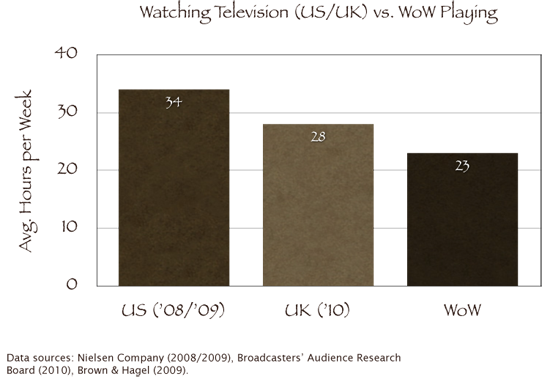
Graph: US television watchers averaged 34 hours per week. British watchers averaged 28 hours. Contrast this with the average WoW player spending 23 hours per week. Sources: Nielsen Company, Broadcasters’ Audience Research Board, and Brown & Hagel.
How much time are they spending? John Seely Brown and John Hagel in a 2009 Business Week article put the average time spent in World of Warcraft at 23 hours per week (Hagel and Brown, 2009). This matches up fairly closely to Nick Yee’s 2005 study average of 21 hours per week for MMORPG players (Yee, 2005c). People are often critical of the time they perceive game players spending in game. Is the time that unreasonable? The Nielsen Company says the average American spent almost 34 hours per week watching television during the 2008-2009 television season (The Nielsen Company, 2009). The Broadcasters’ Audience Research Board, the UK equivalent of the Nielsen Company, shows that the average Briton wiled away 28 hours a week watching television in 2010 (Broadcasters’ Audience Research Board, 2011). That’s more time than the average WoW gamer spends and game playing is an active, thinking process, not passive like television watching.
Preconceptions: Age
According to the Entertainment Software Association, the average game player is 34 years old and has been playing games for 12 years. Yee’s demographics showed that less than 20% of players were teenagers (Yee, 2008). This is corroborated by the Pew Internet & American Life Project’s 2008 study showing only 21% of surveyed teens were spending time in massively multiple online games, including WoW (Lenhart et al., 2008). The majority of WoW players are over 20 years old. Why is this important? This is the population we see in higher education, especially online higher education where I work.
Robert and Susan
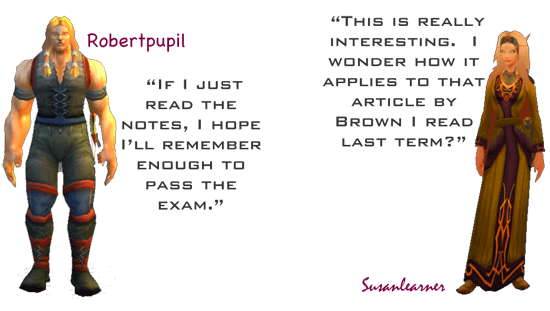
Image: Biggs’s Robert and Susan higher education archetypes. Robert thinks, “If I just read the notes, I hope I’ll remember enough to pass the exam,” whereas Susan thinks, “This is really interesting. I wonder how applies to that article by Brown I read last term?”
UK higher education is in crisis and I do not mean financially. That is a topic for an entirely different talk. The crisis I am thinking of is around the nature and quantity of students we see in higher education. Robert, based on an archetype developed by John Biggs (Biggs and Tang, 2007), operates consistently at the lower levels of Bloom’s Taxonomy: knowledge, comprehension, and application. We want Susans, students capable of independent thought and the higher-level cognitive skills of analysis, synthesis, and evaluation. Universities used to be full of Susans. No matter how bad we were as teachers, the Susans would probably learn. The tables have turned. Government policies pushing more students into universities plus encouraging a culture of teaching to the test have resulted in universities having more Roberts than Susans. The Roberts are interested in the shortest path. We’re catering to this with our course designs and assessment policies.
Catering to Roberts
Jennifer Momsen et al. published a study in late 2010 examining the undergraduate biology courses offered by 50 different faculty across different American institutions over two years (Momsen et al., 2010). For each course, the researchers analyzed the syllabus goals and 9700-some exam/quiz questions, rating each according to Bloom’s Taxonomy. The results are frightening and not, I suspect, particular to biology alone. 93% of the test questions were at levels 1 and 2 on the taxonomy. The goals were somewhat loftier, with only 69% at those same two levels. This study tells us two things: one, there’s a disconnect between what our goals are and how we’re assessing and two we’re encouraging shallow learning. That’s why it’s no surprise that another study of 2300 students found that at least 45% of students were progressing through the first two years of American higher education without measurable gains in critical thinking, complex reasoning, and writing skills (Arum & Roksa 2011, cited in NPR Staff, 2011, includes book excerpt).
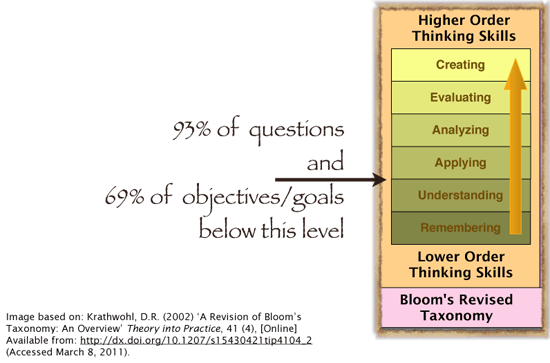
Figure: Bloom’s Revised Taxonomy (Kratwohl, 2002) contains 6 levels, with creating at the top and remembering at the bottom. 93% of questions and 69% of the objectives/goals in Momsen et al.’s (2010) study were below level 2 and therefore lower order thinking skills.
Our students are not that different from the WoW players, particularly in online higher education, which is where I work. How many of you believe your students are spending 23 hours a week on your course? How about across all their courses? I’m dubious too. Why is that? If they can spend 23 hours playing World of Warcraft or 28 hours watching television, why can’t they spend that kind of time on their studies? The answer’s simple: they don’t want to for the most part.
I am not saying that pedagogy and assessment aren’t an issue here. Good teaching, Biggs & Tang, say, is getting Roberts to use those higher level processes to achieve the intended outcomes in the same way that Susans do spontaneously (Biggs and Tang, 2007 p.11). We’re probably failing there too often. However, learning is a multi-person, collaborative and even social enterprise. We as educators have a part to play but the students do too. Their motivation and participation is a central piece of the puzzle.
Quest Anatomy 101
Through most of the game until you reach the top level, your primary activity will be questing. You can think of quests as being a combination of learning objectives plus the actual task to be done, so there is an obvious correlation between what you are asked to do, how you can do it, and how you can tell that you have successfully completed it. Here is a typical quest:
Quest: Taking Battle to the Enemy
“The coliseum is perched in the most dangerous part of the world. The territory we’ve taken from the Scourge has been paid for in blood and misery, yet the enemy continues to strike back with a seemingly limitless army. To make matters worse, this undead army is supported and assisted by mortal sympathizers, the Cult of the Damned.”
This is the reason and backstory behind what you’re going to be asked to do.The actual task is to “Go forth into Icecrown and slay any cultists you encounter.”
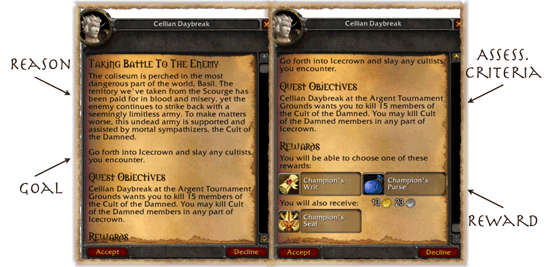
Ceilian Daybreak is located at the Argent Tournament Grounds. Because he is the person who is asking, he is also the person to whom we should return when we have satisfied the quest’s objectives of “kill[ing] 15 members of the Cult of the Damned”. We’re given the additional instruction that we “…may kill Cult of the Damned members in any part of Icecrown.” If we needed to return to someone else with proof of our success, that would also be listed. Finally, we’re told what we will be given upon successful completion. Here it’s money, a type of token, and our choice of increased reputation for one of the game factions (the Champion’s Writ) or some additional gold (Champion’s Purse). We would also receive experience points or their gold equivalent, although this isn’t specifically mentioned.
This is just one of 9600-some quests documented by WoWHead, an extensive community-driven WoW information database (WoWHead, 2011). Many quests are part of chains, where you’re led step by step through the lore or some activity in the world. Each one provides you with much the same information.
World of Workcraft
Not everything in WoW is fun. A lot of it is work: hard work, boring work. Repeatedly doing the same thing over and over again is called grinding. There are many kinds of grinds in WoW: equipment grinding, grinding for gold to buy resources, grinding for resources to make food, potions, or other special consumable items that boost your performance, grinding to obtain rare pets, or grinding to get various achievements. This is not fun! This is work! Welcome to World of Workcraft. Why do people do it and, more importantly, why do they voluntarily do it?
Jane McGonigal, in her recent book Reality is Broken, comments: “Game developers know better than anyone else how to inspire extreme effort and reward hard work. They know how to facilitate cooperation and collaboration at previously unimaginable scales.” (McGonigal, 2011a) She’s talking about motivation, motivation that comes from inside. World of Warcraft is excellent at this, which is why its player base is so much larger and varied than any other online game in history. Bernard Suits defines playing a game as “…the voluntary attempt to overcome unnecessary obstacles.” (quoted in McGonigal, 2011b) How does WoW facilitate and encourage that?
Work Makes Us Happy
Hard work makes us happy. That’s what Jane McGonigal claims (McGonigal, 2011a, McGonigal, 2011d). She identifies six types of work (McGonigal, 2011b). They all have their purpose and they all affect how we feel about ourselves. Even some of the tasks I’ve described as grinding, which might be equivalent to busywork, are beneficial at times when we just need to disengage our mind. However, harder work, especially success at it, releases a cocktail of complex neurochemicals, chemicals that affect our brain’s arousal and reward systems.
“We only ever play [games] because we want to. Games don’t fuel our appetite for extrinsic reward… Instead, games enrich us with intrinsic rewards. They actively engage us in satisfying work that we have the chance to be successful at… And if we play…long enough, with a big enough network of players, we feel a part of something bigger than ourselves…”
- Jane McGonigal (2011c)
Doing satisfying work is an intrinsic reward. Being successful is an intrinsic reward. Social connections provide intrinsic rewards. Belonging to something, participating in something bigger than ourselves, and making a contribution helps satisfy our cravings for meaning, another intrinsic reward. McGonigal claims these four things appear commonly in the last decade’s positive psychology findings (McGonigal, 2011c). Doing hard things and succeeding at them makes us happy and makes us want to repeat the experience. Doesn’t doing hard things sound a lot like learning?
Fiero: Hakkar Dies
When I was growing up, my dad used to watch Wide World of Sports, a show that showcased athletic events from around the world. I never watched it, but I well remember hearing the introduction which had the following line:
“Spanning the globe to bring you the constant variety of sport… the thrill of victory… and the agony of defeat… the human drama of athletic competition…”
Wikipedia, 2011
The thrill of victory. The agony of defeat. These are the phrases that stuck in my head and epitomize so much of game playing in World of Warcraft and of life. When people are challenged but don’t quite succeed, it’s actually extremely motivating. When you are learning an encounter with a boss, it is not unusual to get the boss’s health points down to 1% (or less!) and then wipe. 1%! If only someone had managed to get in one more shot or if only someone had managed not to die for just a bit longer. 1%! Argggh! You can almost feel the vibration of the collective groan that goes up from the players. That’s the agony of defeat. You can feel that success is close. It’s achievable.
On the flip side, we have victory. Victory is sweet. Do you remember the last time you succeeded at something and felt a rush of pride and joy? I first encountered the Italian term fiero in Nicola Lazzaro’s 2004 white paper Why We Play Games (Lazzaro, 2004). In it, she describes fiero as “Personal triumph over adversity. The ultimate game emotion. Overcoming difficult obstacles players raise their arms over their heads. They do not need to experience anger prior to success, but it does require effort.” —that’s the thrill of victory.

One of my favourite moments in World of Warcraft is the killing of Hakkar. Our 20-person group had been trying to complete Hakkar’s dungeon for the better part of a year. Hakkar was the last boss and you had to kill all the other bosses first. This was hard because it all had to be done within a week period because dungeons reset weekly. We didn’t make it to Hakkar every week. The few times we did, we wiped over and over and over again. When we finally succeeded, the players were yelling. They were exultant. I was exultant. It was fiero. Even remembering it now, 4 years later, brings back that feeling. That feeling is addictive. We want to feel that. We have a choice: persist or die! It’s a choice we’re voluntarily making.
Lessons To Learn
John Seely Brown and John Hagel outlined 8 lessons in 2009 that businesses could learn from World of Warcraft to foster creativity and promote innovation (Hagel and Brown, 2009). I believe these same lessons could be applied to the design of education:
- Reduce barriers to entry and to advance in initial stages.
- Provide rich performance metrics.
- Keep raising the bar.
- Remember to account for and use intrinsic motivations.
- Provide opportunities to develop shared knowledge not easily shared but don’t forget broader knowledge exchange.
- Create opportunities for teams to self-organize around challenging goals.
- Encourage frequent performance feedback.
- Create an environment that rewards new dispositions.
Some of these we have already looked at, like accounting for and using intrinsic motivations. We also saw how teams, large and small, fixed and ad-hoc, can self-organize around challenging goals. Guilds and fixed teams provide opportunities to share knowledge, both tacit and factual. The others likely require some discussion. For the first, it is easy to start in the game. You begin at level 1 but you’re guided through a series of ever more difficult quests—the bar is constantly rising. Levelling up is quick and easy in the initial stages. This is what reducing barriers to entry means. People do not need to invest much to get started. It’s low-risk and high reward, which helps get people interested and keeps them interested.
New Dispositions
The last “lesson” is to create an environment that rewards new dispositions. In an earlier article John Seely Brown and Douglas Thomas describe the “gamer disposition”, characteristics Brown thought World of Warcraft encouraged. These included being bottom-line oriented, thriving on change, understanding the power of diversity, believing learning is fun, and “marinating on the ‘edge’” (Brown and Thomas, 2008). This last one means that gamers, even when they know of a working solution, will often try out other strategies, looking for a better solution. They are not afraid to experiment or to try something completely outrageous. Aren’t these characteristics we would like our students to exhibit?
Failure Is Good
I’d like to add an additional “lesson”: Failure is desirable, provided the consequences are manageable. Gamers are not afraid to fail, repeatedly. In games, failure is what leads to innovation and learning. It also leads eventually to success and fiero. We are often afraid to let people fail. It lowers retention rates, which lowers our funding, but it also leads to grade inflation and degradation of our degrees. It’s a slippery slope and we may be denying students the opportunity to feel real satisfaction.

Figure: Failure leads to success, fiero, innovation, and learning; but only when consequences manageable.
The previous World of Warcraft expansion, Wrath of the Lich King, was widely regarded by hardcore gamers as being too easy. Blizzard, the developer, in an attempt to make it appealing and accessible to an even wider audience, dumbed down the encounters and made getting gear easy. Because you didn’t need to think, just mindlessly press your fire button (or whatever), the encounters weren’t challenging. Players were just out-gearing and overpowering the encounters. It wasn’t as much fun. Players felt cheated. It definitely was not very satisfying. Fiero was in thin supply.
Blizzard completely reversed that in the latest expansion, released last December. Problem solving and thinking are required. Brute force isn’t enough. It is harder, yes. Some people, used to an easy ride, had to adjust to a new world order and perhaps realize that they needed to earn access to groups going to harder encounters. That means working to get the appropriate gear, working to acquire the necessary supplemental resources, and working to learn how to play well. The people who are willing to fail repeatedly are the people who are able to learn, to innovate, and to improve.
Sample Teamwork: Learning in the World
I hope I’ve demonstrated that we can learn from the World of Warcraft, but what about learning in the world? What kind of learning and where? Let’s start by looking at a (badly edited!) video of a 10-person guild in a recent boss encounter involving two dragons. The complete encounter is almost 8 minutes. I’ve cut the video down to just under 3 minutes.
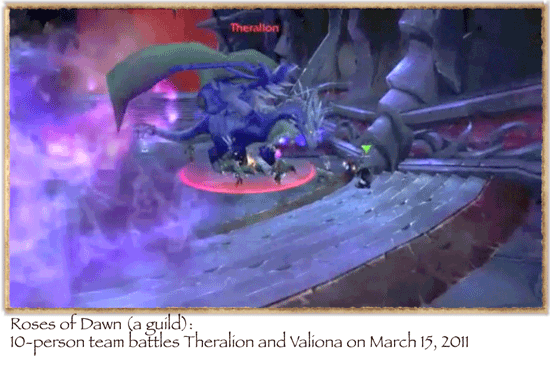
Screenshot: The Roses of Dawn (a guild) ten-person team battles Theralion, one of a dragon duo, on March 15, 2011 in the Bastion of Twilight.
<video: Bastion of Twilight: 2m 55s> [not available online]
There’s a lot going on here. There are two main encounters: one with one dragon on the ground and the other airborne and then the reverse. From my point of view as a healer, I don’t really care much which dragon is on the ground. I see the fight in three phases: the beginning where the dragon periodically casts an ability called “blackout” on a player, which looks to produce enough damage to take out three healthy players. To prevent the blackout player from being killed, 5 or 6 players will congregate nearby to help soak up the damage. In this case, misery shared is damage greatly reduced.
In the next phase, we’re all running away from the dragon and there are swirling circles on the floor. If you are in the circles and get hit with something from the sky, you get sent to a sort of “Twilight Zone”. The third phase has many nasty tricks. First, there’s another “blackout” like effect. That’s why you see the ranged players all stacked up together at a distance. While they’re standing together, the flying dragon periodically uses a breath weapon to make big, black holes in the ground. There’s also a magic spell cast on a ranged person which results in them damaging other players around them every time they cast. If that’s not enough, the flying dragon strafes the group with its hot pink breath too.
You can’t see it here, but if we fail to move out of pink bits or black bits, or don’t stack up enough on a blackout person, or any number of other things, we die. If one person dies, as did happen here late in the encounter, there is still a chance of success. In all of our previous efforts, we lost a number of people to the pink breath or black circles on the ground and the group wiped. Many times.
Basil Leads
You cannot hear our voice communications. Basil, our leader, is giving instructions as things happen, like “Middle’s safe” or “Nooo! The middle’s not safe!”, to tell people how to avoid the random direction of the pink breath weapon or maybe telling people to stack up and where. The healers are warning each other about things going wrong with the players’ health. There is a wealth of communication occurring to coordinate the complex dance required to be successful at this encounter.
When I asked Basil about raid leading and things he had learned, he told me he didn’t start off being a good leader. Practice certainly helped, but he has the ability to communicate and to learn.
Basil: Action Reseacher
When preparing for a new encounter, he starts by reading up on the various abilities of the bosses (if known), making a mental picture of what they are going to do or what it is going to look like, and then theorizing about what can be done to avoid the “bad stuff.” This model and theory is communicated to the group in a discussion before the encounter and then tried out several times, making small refinements or, sometimes, big refinements as he gains experience and members contribute ideas. It’s close to McNiff’s description of action research (McNiff, 2002).

Figure: McNiff’s (2002) six stages of action research: research, mental model, plan, try, review and revise, and repeat the first five as necessary. Basil, a night elf rogue pictured here, is engaging in this process.
Communities of Practice (1)
Teamwork and community have already been mentioned several times, with the game providing mechanisms for both ad-hoc groups and fixed groups of people in guilds. Guilds can be very large or very small. Ducheneaut et al. did some interesting research in 2006 where they enumerated guilds they saw on 5 different servers. Of the 3500-some guilds they had seen in July, just over 1900 were not seen in December, a 54% death rate (Ducheneaut et al., 2007). There are, of course, all kinds of caveats about their methodology, but the number is likely reasonably accurate and reflects my own experiences with watching guilds form and die over the years. While it sounds like these groups are fragile, they did also note that the longer a guild had been around, the more likely it was to stay around. Running a guild, as I know from personal experience, is not easy. It’s another place for people to learn the art of leadership and some people fail initially or several times.

Figure: Wenger’s (2008) key characteristics for a community of practice: joint enterprise, mutual engagement, and shared repertoire. Each of those is accomplished via various methods, like doing things together for mutual engagement, stories for a shared repertoire, and mutual accountability for joint enterprise.
Guilds, however, are essentially communities of practice, an idea formalized by the work of Jean Lavé & Etienne Wenger. Wenger defines a communities of practice as “…groups of people who share a concern or passion for something they do and learn how to do it better as they interact regularly…” (Wenger, 2006). Doesn’t that sound familiar to some of the behaviour we’ve seen exhibited? Guilds have a culture and whether that culture revolves around playing well, role-playing, or just casually having fun, the guild is a community who becomes more and more cohesive and better at what it does over time. Guilds tend to exhibit Wenger’s key characteristics of mutual engagement (which can include peripheral participation — the silent watcher who is always there, but doesn’t say anything), joint enterprise, and a shared repertoire.
Similar to WoW?
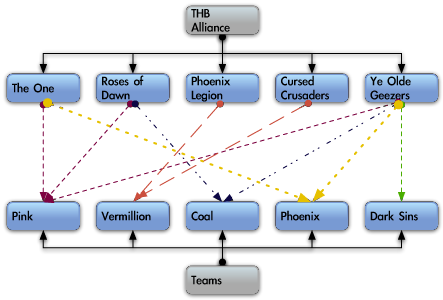
Figure: The Honourbound Alliance team structure in 2010. There were five guilds (top row) contributing members to 5 different, primarily cross-guild teams (bottom row). The exception is Dark Sins, which was made up only of Ye Olde Geezers members. Ye Olde Geezers contributed members to every one of the cross-guild teams, whereas other guilds typically only contributed to one or two teams.
The Honourbound Alliance (THB), pictured here, is an alliance of social guilds founded 5 years ago. Most of the guilds in it date back to the game’s release. The membership of these guilds and most guilds is self-selected. The guilds have an identity, shared experience, and shared knowledge. They last as long as members have an interest in maintaining the community and improving the shared practice. That is not too dissimilar to what happens at The Open University, an accredited distance education university in the UK. Students are given online tutor groups and often course-wide forums or course-wide social spaces. Both e-learning and bricks-and-mortar students form Facebook groups. Virtual and live study groups, meeting in coffee shops, in homes, on Twitter or Skype, are not uncommon. Membership in course and a study group is very similar to a guild: self-selected, with a particular purpose and identity, and a duration which is often, but not always, limited to the duration of the course; they can carry on afterwards. So again, WoW and higher education share some commonalities.
Similar to E-Learning?
John Seely Brown and Richard P. Adler in Minds on Fire relate the results of a study by Richard Light at Harvard that showed “…one of the strongest determinants of students’ success in higher education—more important than the details of their instructors’ teaching styles—was their ability to form or participate in small study groups.” (Brown and Adler, 2008) So pedagogy is important, but not as important as people learning to work together to share knowledge and practice. Study groups fit into lower right-hand quadrant, strongly in the realms of “non-formal” or “informal learning” in Marcia Conner’s learning space (Conner, 2009).

Credit: Figure by Marcia Conner, all rights reserved.
Figure: Conner (2009) mapped formal and informal learning onto a y-axis and intention and unexpected onto an x-axis to produce a two-dimensional graph. In the upper left quadrant (formal), classes and meetings. In the upper right quadrant (unexpected), social media and self study. Bottom left (intentional) includes reading and mentoring. The bottom right (informal) contains community and playing.
Learning/Improving Self
WoW is a problem-based learning environment with a continuous assessment process. You never have to take a “test” to prove you know something. The act of doing in the game is the test. We have also looked at how guilds are communities of practice for learning, culture, and game practice and how people are intrinsically motivated to engage in research, model building, and debate in order improve their performance or solve things in a different fashion. You might wonder if people go into World of Warcraft specifically to learn. My research looks at learning in World of Warcraft to see what kinds of practices we can adopt specifically in online higher education that will encourage community formation, motivation and persistence. Last year I did a small study where I invited players to write a short essay about why they play World of Warcraft. They were primed somewhat with an essay I had written about why I play (Hoyle, 2009), but they were not specifically asked to relate incidents of teaching or learning. I thought you might find it interesting to hear some of the things they said.
51 people started the survey and completed the first part about in-game demographics. Only 39 completed the whole survey, including the essay question. Most of the participants played on the European servers and most played on player versus the environment servers, rather than role-playing or player versus player servers. The following examples have been tagged as examples of learning while reading through the submitted essays. The spelling has been preserved and I have assigned a unique name to each different participant. The assigned names will be used in this and any other published materials relating to the study
“I enjoy playing as part of a roleplaying group most. The interactions in character, the humour, the banter are what makes me tick. That and being able to explore different sides of my personality.”
- Scandia
“I’ve been invited to join guilds but has so far declined – hoping to build my inworld skills first – and bring a friend along (one is currently ’training’, which is the real reason for the 2nd trial run). I particularly need to build skills in chatting in world and the friend is helping me along – as are the occassional people I encounter inworld.”
- Sulfurus
I have so far tagged 15 to 20 examples of learning that people found motivated them to play the game. I found it surprising people were playing in order to improve their social abilities or to learn more about themselves and other people.
Raiding & Learning
“It’s kinda the same thing with character progression, wanting to improve by reading about skill usage, by collecting new gear, trying out different specs/rotations, … Check how you do compared to others, analyse what you do differently & how you can improve.”
- Stannus
“I enjoy the sense of achievement of building up professions, building skills or completing quests. Learning how to play each class, and trying to work out what that character is and how they would react to different scenarios is what motivates me.”
- Scandia
Here we can see people model building and researching in the above examples, in order to learn to play better. This was not surprising to me.
Learning Languages
“I may add a minor point to the list of reasons why people play WoW: I wanted to train my english skills. As I’m not a native speaker (coming from Germany) the chat and the ventrilo communication help me to keep my english alive – I don’t have many other opportunities.”
- Beryl
“since i am a norwegian i also can practise some english, which is a good thing.”
- Potassio
“wow fore me is to chat and gaming with freinds and ofcourse inprove my english in both wright and reading.”
- Aluminio
The last several examples are very interesting as I wouldn’t have seen those if the majority of players had come from the North American game servers. Blizzard regionalizes the game. While Europe does have some dedicated single-language servers. the majority have players from all over Europe and Russia. The North American servers have players primarily from North America, Australia, and New Zealand. In North America, you’re far less likely to encounter players from other countries or players speaking other languages, whereas it’s fairly common on the European servers. It, therefore, for Europeans, makes a great place to go and practice many different languages, which is what we’re seeing reflected here.
Study: Tags Used
I fed Wordle a delimited list of tags allocated so far in the study along with the frequency with which the tag was used. Wordle attempts to aesthetically arrange and represent the tags by frequency usage. The larger the word in the diagram, the more often it was used.
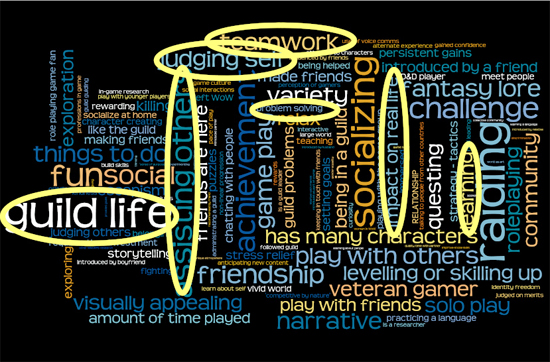
You can see some interesting things appearing. “Guild life”, “team work”, and “assisting others” feature quite prominently. People are greatly invested in their social groups and into contributing to those groups and the wider culture. “Judging self”, where people analyze their own capabilities and performance, is also a recurring theme. “Impact on reality” is where people have said something about the game affecting their life, either positively or negatively. I’m currently trying to do a more sophisticated analysis that correlates things specifically identifiable as motivation or persistence with those tags, to get a feeling of which are things only mentioned in passing versus being a key component to the question of motivation and persistence. There’s much left to explore.
Recommended Reading
If you’d like to learn more about how games foster literacy and learning and how they can make a different, I recommend the following two books: James Paul Gee’s “What Video Games Have To Teach Us About Learning and Literacy” and Jane McGonigal’s just released “Reality Is Broken”.
Thanks
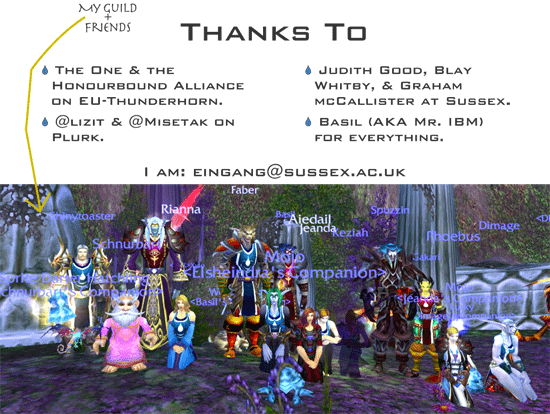
Image: Group shot of my guild at a guild birthday party. Thanks to The One (my guild) and The Honourbound Alliance on EU-Thunderhorn. Thanks also to @lizit and @misetak on Plurk, Drs. Good, Whitby, and McCallister and the HCT group at the University of Sussex; and Basil for everything.
In going from the real me to the virtual me in World of Warcraft, I have learned so much about myself, learning, communities, and motivation. I have learned to embrace failure, because, really, the choice is simple: persist or die.
More Information
The slides will be posted on SlideShare. There is more information about my research on the WoW Learning Project website at http://wowlearning.org/. Contact me at Sussex: eingang AT sussexDOTacDOTuk. Or follow me on Twitter, where I’m @Eingang.
Thank you.
Disclaimer: No toilets were cleaned in the making of this presentation.
References
Biggs, J. & Tang, C. (2007) ‘Chapter 1: The Changing Scene in University Teaching’, in Teaching for Quality Learning at University, 3rd edition. Maidenhead, United Kingdom:Open University Press. pp. 1-14.
Blizzard Entertainment, I. (2010) World of Warcraft(®) Subscriber Base Reaches 12 Million Worldwide, [online]. Available from: http://eu.blizzard.com/en-gb/company/press/pressreleases.html?101007 (Accessed March 14, 2011).
Broadcasters’ Audience Research Board. (2011) Monthly Total Viewing Summary, [online] Broadcasters’ Audience Research Board. Available from: http://www.barb.co.uk/report/monthlyViewing (Accessed March 12, 2011).a
Brown, J.S. & Thomas, D. (2008) ‘The Gamer Disposition’, Harvard Business Review, blog entry posted February 14, 2008. Available from http://blogs.hbr.org/cs/2008/02/the_gamer_disposition.html (Accessed March 16, 2011).
Brown, J.S. & Adler, R.P. (2008) ‘Minds on Fire: Open Education, the Long Tail, and Learning 2.0’ EDUCAUSE Review, 43 (1), [Online] Available from:http://connect.educause.edu/Library/EDUCAUSE+Review/MindsonFireOpenEducationt/45823 (Accessed August 22, 2008).
Churches, A. (2008) Bloom’s Digital Taxonomy, [online] PDF. Available from:http://edorigami.wikispaces.com/Bloom’s%20Digital%20Taxonomy (Accessed March 8, 2011).
Conner, M. (2009) Introducing Informal Learning, [online]. Available from: http://marciaconner.com/intros/informal.html(Accessed June 11, 2009).
Ducheneaut, N. et al. (2007) ‘The Life And Death of Online Gaming Communities: A Look at Guilds in World of Warcraft’, in Proceedings of the SIGCHI Conference on Human Factors in Computing Systems (SIGCHI 2007), San Jose, CA, United States, April 28 – May 3, ACM. pp:839-848. Also available from: http://doi.acm.org/10.1145/1240624.1240750.
Entertainment Software Association (2010) 2010 Essential Facts about the Comnputer and Video Game Industry,Entertainment Software Association. Available from: http://www.theesa.com/facts/gameplayer.asp (Accessed March 8, 2011).
Gee, J.P. (2007) What Video Games Have To Teach Us About Learning and Literacy. 2nd edition. New York, NY, United States:Palgrave Macmillan.
Gillepsie, L. (2011) World of Warcraft in School, [online]. Available from:http://wowinschool.pbworks.com/w/page/5268731/FrontPage (Accessed March 14, 2011).
Gladwell, M. (2008) Outliers: The Story of Success. Kindle edition. Penguin Group.
Hagel, J. & Brown, J.S. (2009) ‘How World of Warcraft Promotes Innovation’ Business Week Online, January 14 [Online] Available from: http://www.businessweek.com/innovate/content/jan2009/id20090114_362962.htm (Accessed March 14, 2011).
Hoyle, M.A. (2009) ‘World of Warcraft and Me: A True Confession’, E1n1verse – WoW, Learning, and Teaching by Michelle A. Hoyle, blog entry posted August 4, 2009. Available from: http://einiverse.eingang.org/2009/08/04/world-of-warcraft-and-me-a-true-confession/ (Accessed July 15, 2010).
Irdeen, Myndflame & Gameriot. (2010) Boom de Yada WoW – Eng Subtitles, [online] Video, YouTube. Available from:http://www.youtube.com/watch?v=oOZBU257ERE (Accessed March 14, 2011).
Jenkins, H. (2004) ‘Reality Bytes: Eight Myths about Video Games Debunked’, The Video Game Revolution, blog entry posted 2004. Available from: http://www.pbs.org/kcts/videogamerevolution/impact/myths.html (Accessed March 8, 2011).
Krathwohl, D.R. (2002) ‘A Revision of Bloom’s Taxonomy: An Overview’ Theory into Practice, 41 (4), [Online] Available from: http://dx.doi.org/10.1207/s15430421tip4104_2 (Accessed March 8, 2011).
Lazzaro, N. (2004) Why We Play Games: Four Keys to More Emotion without Story, XEODesign, Inc. Available from:http://www.xeodesign.com/whyweplaygames/xeodesign_whyweplaygames.pdf (Accessed February 12, 2011).
Lenhart, A. et al. (2008) Teens, Video Games, and Civics, Pew Internet & American Life Project. Available from:http://www.pewinternet.org/Reports/2008/Teens-Video-Games-and-Civics.aspx (Accessed February 21, 2010).
McGonigal, J. (2011a) ‘Introduction’, in Reality Is Broken: Why Games Make Us Better and How They Can Change the World, Kindle edition. Vintage Digital.
McGonigal, J. (2011b) ‘Chapter 1: What Exactly Is a Game?’, in Reality Is Broken: Why Games Make Us Better and How They Can Change the World, Kindle edition. Vintage Digital.
McGonigal, J. (2011c) ‘Chapter 2: The Rise of the Happiness Engineers’, in Reality Is Broken: Why Games Make Us Better and How They Can Change the World, Kindle edition. Vintage Digital.
McGonigal, J. (2011d) ‘Chapter 3: More Satisfying Work’, in Reality Is Broken: Why Games Make Us Better and How They Can Change the World, Kindle edition. Vintage Digital.
McNiff, J. (2002) Action Research for Professional Development: Concise Advice to New Action Researchers, 3rd edition, [Online] Available from: http://www.jeanmcniff.com/booklet1.html (Accessed June 23, 2010).
Meloni, W. (2010) ‘The Next Frontier – Female Gaming Demographics’, Gamasutra, blog entry posted 2010. Available from:http://www.gamasutra.com/blogs/WandaMeloni/20100330/4812/The_Next_Frontier__Female_Gaming_Demographics.php
Momsen, J.L. et al. (2010) ‘Just the Facts? Introductory Undergraduate Biology Courses Focus on Low-Level Cognitive Skills’, CBE-Life Sciences Education, 9 (Winter 2010), pp:435-440. Also available from: http://dx.doi.org/10.1187/cbe.10-01-0001 (Accessed March 14, 2011).
NPR Staff. (2011) A Lack of Rigor Leaves Students ‘Adrift’ in College, [online] NPR. Available from:http://www.npr.org/2011/02/09/133310978/in-college-a-lack-of-rigor-leaves-students-adrift (Accessed March 14, 2011).
South Park Digital Studios. (n.d.) South Park Studios UK and Ireland – Preparing for Battle, [online] Clip from Season 10, Episode 8. Available from: http://www.southparkstudios.co.uk/clips/sp_vid_155271/ (Accessed March 11, 2011).
The Nielsen Company. (2009) ‘Average TV Viewing for 2008-09 TV Season at All-Time High’, Nielsen Wire, blog entry posted November 10, 2009, 2009. Available from: http://blog.nielsen.com/nielsenwire/media_entertainment/average-tv-viewing-for-2008-09-tv-season-at-all-time-high/ (Accessed March 12, 2011).
Wenger, E. (2008) Communities of Practice: Learning, Meaning, and Identity. New York, NY, United States:Cambridge University Press.
Wenger, E. (2006) Communities of Practice: A Brief Introduction, [online] web page. Available from:http://www.ewenger.com/theory/index.htm (Accessed February 21, 2010).
Wikipedia. (2011) Wide World of Sports (U.S. TV Series), [online] Wikipedia. Available from:http://en.wikipedia.org/wiki/Wide_World_of_Sports_(U.S._TV_series) (Accessed March 16, 2011).
WoWHead. (2011) WoWHead: Database: Quests, [online]. Available from: http://www.wowhead.com/quests (Accessed March 16, 2011).
Yee, N. (2004) Player Demographics, [online] The Daedalus Gateway. Available from: http://www.nickyee.com/daedalus/gateway_demographics.html (Accessed March 14, 2011).
Yee, N. (2005a) Playing with Someone, [online] The Daedalus Gateway. Available from: http://www.nickyee.com/daedalus/archives/001468.php (Accessed March 14, 2011).
Yee, N. (2005b) WoW Basic Demographics, [online] The Daedalus Gateway. Available from: http://www.nickyee.com/daedalus/archives/001365.php (Accessed November 2, 2011).
Yee, N. (2005c) MMORPG Hours vs. TV Hours, [online]. The Daedalus Project. Available from: http://www.nickyee.com/daedalus/archives/000891.php (Accessed February 21, 2010).
Yee, N. (2008) The Daedulus Project, [online]. Available from: http://www.nickyee.com/daedalus/docs/shared-data.php(Accessed February 16, 2011).
Citing
Here are author-date references for the different versions of this material:
- Original talk: Hoyle, M.A. (2011) ‘Persist or Die! Learning in World of Warcraft’, presented at Game To Learn: Take 2, Dundee, Scotland, March 17 – March 19. Also available from: http://www.slideshare.net/Eingang/persist-or-die-learning-in-world-of-warcraft.
- Slides: Hoyle, M.A. (2011) Persist or Die! Learning in World of Warcraft, [online] Slide presentation (with notes). Available from: http://www.slideshare.net/Eingang/persist-or-die-learning-in-world-of-warcraft.
- This version: Hoyle, M.A. (2012) ‘Persist or Die! Learning in World of Warcraft’. WoW, Learning, and Teaching by Michelle A. Hoyle blog entry posted August 8, 2012. Available from: http://einiverse.eingang.org//2012/08/08/persist-or-die/.
- PDF blog version: Hoyle, M.A. (2011) Persist or Die! Learning in World of Warcraft. Available from: http://einiverse.eingang.org/files/2012/08/Hoyle_2011_Persist_or_Die.pdf.
Version Information
- V3, November 28, 2011: Fixed the various Yee citations to point at the correct articles and references. Fixed some conversion errors (but posted July 14, 2012 on WoWLearning.org and August 8, 2012 on Einiverse.eingang.org).
- V2, September 23, 2011: Fixed some conversion errors.
- V1, September 16, 2011: Original version.







